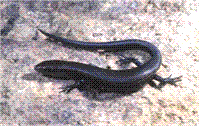Family
Scinciae (skinks)
Genus
Lampropholis
Species
delicata
Threats/Control Methods - Regional
Overall, the regional population of Delicate Skinks is not threatened, however, individuals and local populations may be affected by urban developments. In their favour, however, Delicate Skinks do have the ability to recolonise gardens at a later date.
Threats/Control Methods - Local
The Delicate Skink may be preyed upon by domestic animals.
Local/Urban Actions
For the greatest opportunity to see Delicate Skinks in urban areas such as yards or gardens, it is advantageous to stop domestic animals from disturbing habitat such as leaf litter.
Common name/s
Delicate Skink
Distinguishing Features
The Delicate Skink is coppery brown above, usually without markings. The species has a pale whitish belly. It grows up to around 9 cm including tail, with the tail generally making up around half the length.
Similar Species
The Garden Skink (Lampropholis guichenoti ) can be distinguished from the Delicate Skink by the dark stripe down the side of its body and the scattered dark markings across its back. The Garden Skink tends also to be more grey to olive coloured.
Distribution
The Delicate Skink has a large range extending along the east coast of Australia, with populations usually occurring on or east of the Great Dividing Range. The species occurs from Cairns in the north, through eastern NSW to eastern Victoria. Disjunct communities also occur in Eastern Tasmania and southern South Australia. The Delicate Skink occupies most areas of the ACT, with populations occurring in the Brindabellas to the south and west, the grazed grassy woodlands of the north, and the gardens and parks of Canberra.
Country of Origin
Australia
Survey Techniques
Pitfall trapping and hand searching are methods typically applied to survey this species. Hand searching was used to locate the lizards at the ANU.
Conservation (Pet/Pest) Status - National
A common species across eastern Australia.
Conservation (Pet/Pest) Status - Regional
Common around the ACT. Captive-bred Delicate Skinks may be kept by hobbyists with at least two years experience in keeping lizards (see Reptile Policy).
LSCCES Population
Reasonably common in suburban Canberra. Observed on the ANU campus in survey work for the LSCC ecological survey.
Associated vegetation community
The Delicate Skink can occur in a wide variety of habitats; wet and dry sclerophyll forests, woodlands and grasslands.
Limiting Resources
Due to the adaptive nature of the Delicate Skink, the only main limiting resource is access to sustained food resources.
Breeding
The Delicate Skink lays between 1-8 eggs per clutch, with these eggs usually laid in summer. The species will sometimes lay in communal nests with other skinks.
Behaviour
The Delicate Skink is mainly diurnal, though it may also be active on warm evenings. Tends to be ground dwelling, although it can climb quite well. The skink will forage under litter and ground debris and shelters under rocks.
Functional Group
Insectivore
Food Species
The species eats a wide variety of invertebrates.
Predators
The Delicate Skink is often preyed upon by snakes. The Eastern Brown Snake (Pseudonaja textiles) and the Eastern Copperhead (Austrelaps superbus) are known predators.
Interesting Fact
The Delicate Skink is sexually dimorphous (males and females display different traits), with females of the species being larger than males and the different sexes occupying different places within the same habitat area.
References - (reader suitability of references, P=Primary teachers, S=Secondary students, T=Tertiary students and researchers)
Books:
Bennett, R. 1997. Reptiles & frogs of the Australian Capital Territory. National Parks Association of the ACT, Woden. S, T
Cogger, H.G. 1996. Reptiles and Amphibians of Australia. Reed Books Australia, Melbourne. S, T
Swan, G., Shea, G. and Sadlier, R. 2004. A Field Guide to Reptiles of New South Wales, Second Edition. Reed New Holland, Sydney. S, T
Online Publications:
Greer, A.E. 2006. Encyclopedia of Australian Reptiles. Australian Museum Online, Version date: 7 August 2006. T
http://www.amonline.net.au/herpetology/research/index.htm#encyclopedia
[Last accessed 01/05/07]
Researcher: Ian Rayner

 Top
Top Top
Top